
Berthe Marie Pauline Morisot was a French painter and a member of the circle of painters in Paris who became known as the Impressionists.

Édouard Manet was a French modernist painter. He was one of the first 19th-century artists to paint modern life, as well as a pivotal figure in the transition from Realism to Impressionism.
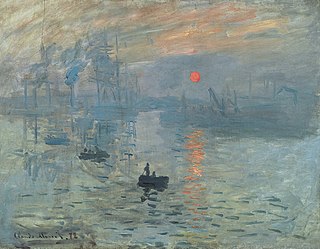
Impressionism was a 19th-century art movement characterized by relatively small, thin, yet visible brush strokes, open composition, emphasis on accurate depiction of light in its changing qualities, ordinary subject matter, unusual visual angles, and inclusion of movement as a crucial element of human perception and experience. Impressionism originated with a group of Paris-based artists whose independent exhibitions brought them to prominence during the 1870s and 1880s.

Mary Stevenson Cassatt was an American painter and printmaker. She was born in Allegheny, Pennsylvania, and lived much of her adult life in France, where she befriended Edgar Degas and exhibited with the Impressionists. Cassatt often created images of the social and private lives of women, with particular emphasis on the intimate bonds between mothers and children.

The Musée d'Orsay is a museum in Paris, France, on the Left Bank of the Seine. It is housed in the former Gare d'Orsay, a Beaux-Arts railway station built between 1898 and 1900. The museum holds mainly French art dating from 1848 to 1914, including paintings, sculptures, furniture, and photography. It houses the largest collection of Impressionist and post-Impressionist masterpieces in the world, by painters including Berthe Morisot, Claude Monet, Édouard Manet, Degas, Renoir, Cézanne, Seurat, Sisley, Gauguin, and van Gogh. Many of these works were held at the Galerie nationale du Jeu de Paume prior to the museum's opening in 1986. It is one of the largest art museums in Europe.

Edgar Degas was a French Impressionist artist famous for his pastel drawings and oil paintings.
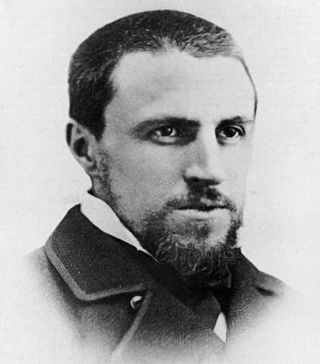
Gustave Caillebotte was a French painter who was a member and patron of the Impressionists, although he painted in a more realistic manner than many others in the group. Caillebotte was known for his early interest in photography as an art form.

Jean-Louis Forain was a French Impressionist painter and printmaker, working in media including oils, watercolour, pastel, etching and lithograph. Compared to many of his Impressionist colleagues, he was more successful during his lifetime, but his reputation is now much less exalted.

Giuseppe De Nittis was one of the most important Italian painters of the 19th century, whose work merges the styles of Salon art and Impressionism.

Les Choristes is an 1877 pastel on monotype by French artist Edgar Degas. Part of a series of similar works depicting daily public entertainment at the time, it shows a group of singers performing a scene from the opera Don Giovanni, the only work by Degas depicting an operatic performance without dancers.

Marie Bracquemond was a French Impressionist artist. She was one of four notable women in the Impressionist movement, along with Mary Cassatt (1844-1926), Berthe Morisot (1841-1895), and Eva Gonzalès (1847-1883). Bracquemond studied drawing as a child and began showing her work at the Paris Salon when she was still an adolescent. She never underwent formal art training, but she received limited instruction from Jean-Auguste-Dominique Ingres (1780–1867) and advice from Paul Gauguin (1848–1903) which contributed to her stylistic approach.

Miss La La at the Cirque Fernando is an oil on canvas painting by the French Impressionist artist Edgar Degas. Painted in 1879 and exhibited at the Fourth Impressionist Exhibition in Paris that same year, it is now in the collection of the National Gallery in London. It is Degas's only circus painting, and Miss La La is the only identifiable person of color in Degas's works. The special identity of Miss La La and the great skills Degas used in painting her performance in the circus made this piece of art important, widely appreciated but, at the same time, controversial.
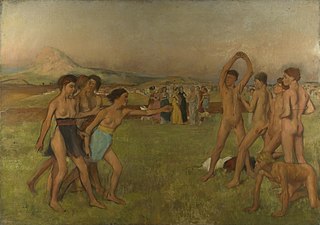
Young Spartans Exercising, also known as Young Spartans and as Young Spartan Girls Challenging Boys, is an early oil on canvas painting by French impressionist artist Edgar Degas. The work depicts two groups of male and female Spartan youth exercising and challenging each other in some way. The work was purchased by the trustees of the Courtauld fund in 1924 and is now in the permanent collection of the National Gallery in London.
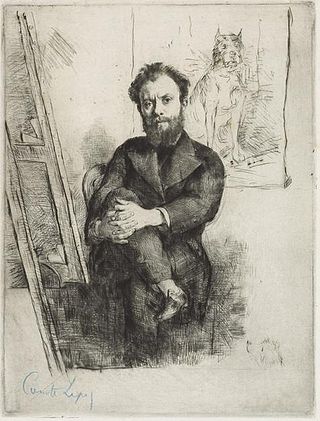
Ludovic-Napoléon Lepic was a French artist, archaeologist and patron of the arts. He was styled as Vicomte Lepic until his father's death in 1875, when he succeeded to the title of Comte Lepic. He is best remembered today as a friend of Edgar Degas, who included him in some eleven paintings and pastels. He was among the original Impressionist group and later became a recognised marine painter.
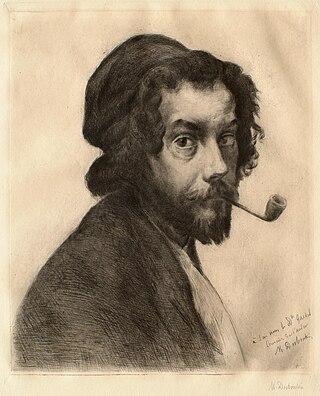
Marcellin Gilbert Desboutin was a French painter, printmaker, and writer. Desboutin always signed himself Baron de Rochefort.

Little Girl in a Blue Armchair is an 1878 oil painting by the American painter, printmaker, pastelist, and connoisseur Mary Cassatt. It is in the collection of the National Gallery of Art, Washington D.C. Edgar Degas made some changes in the painting.

Henri Michel-Lévy, was a French impressionist painter.

Marguerite Charpentier was a French salonist and art collector who was one of the earliest champions of the Impressionists, especially Pierre-Auguste Renoir.

Marie Dihau was a French singer, pianist as well as singing and piano teacher.
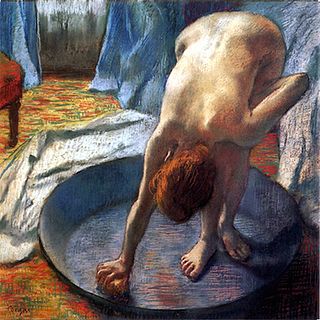
Woman in a Tub is one of a suite of pastels on paper created by the French painter Edgar Degas in the 1880s and is in the collection of the Hill-Stead Museum in Connecticut. The suite of pastels all featured nude women "bathing, washing, drying, wiping themselves, combing their hair or having it combed" and were created in readiness for the sixth and final Impressionist Exhibition of 1886.





















